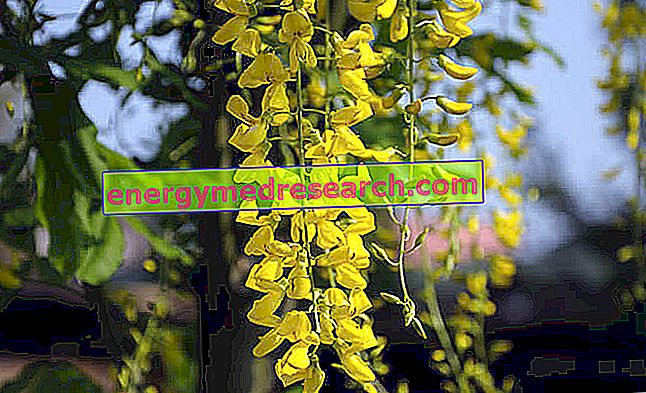Generality
Cytisine is an alkaloid of natural origin found in many plants of the Fabaceae family.
Cytisine is extracted mainly from the laburnum ( Laburnum anagyroides or Cytisus laburnum L.), a plant also known as "fake tobacco" (ie, fake tobacco).

This molecule has been known and studied since the 1960s in Eastern European countries for its effectiveness in the treatment of smoking cessation. However, the studies that were conducted in those years did not meet the parameters required by the Western European clinical trial legislation, for this reason, the use of cytisine in anti-smoking therapy was not taken into consideration.
In 2011, however, the New England Journal of Medicine published a study that confirmed the real efficacy of cytisine in the treatment of smoking addiction. Subsequently, numerous other researches were conducted, up to the most recent studies published in 2015 that demonstrate how the treatment based on cytisine can be even more effective than the classic nicotinic replacement therapy.
Another point in favor of cytisine lies in the economic aspect. Cytisine, in fact, has a much lower cost than other therapies commonly used to treat smoking. It is estimated that the costs for treatment based on cytisine are five to ten times lower than the costs involved in nicotinic replacement therapy and therapy with varenicline (a synthetic drug used in the therapy of smoking and equipped with a mechanism of action similar to that of cytisine).
Cytisine is marketed in Eastern European countries under the name of Tabex®.
In Italy, however, cytisine has been available since May 2015 as a galenic preparation in pharmacies, ie it is produced directly in pharmacies equipped with a galenic laboratory, but only upon presentation of a medical prescription.
Action mechanism

Cytisine - Chemical Structure
Cytisine is a partial agonist of the α4β2 nicotinic receptors present in the brain (the same receptors to which the nicotine binds deriving from tobacco smoke) and has a nicotine-like action.
By binding to these receptors - in addition to decreasing the typical symptoms of nicotine withdrawal - cytisine is also able to reduce and sometimes totally eliminate the sensation of pleasure and gratification induced by smoking.
Unlike varenicline, cytisine causes fewer side effects and, as mentioned above, its cost is much lower.
Interactions
It is important to stress that the effect of cytisine can be influenced by concomitant therapy with antituberculosis drugs.
In any case, it is always good to inform your doctor if you are taking - or have recently taken - any type of medication, including prescription-free medicines and herbal products.
Warnings
Cytisine, although it is a well tolerated drug, must be administered with great caution in patients suffering from certain types of diseases, such as:
- Adrenal cancer;
- Schizophrenia;
- Chronic heart failure;
- Hyperthyroidism;
- Diabetes mellitus;
- Cerebrovascular disorders;
- Gastroesophageal reflux;
- Peptic ulcer and / or duodenal ulcer in remission;
- Renal and / or hepatic impairment.
In addition, cytisine should also be administered with caution in patients less than 18 years of age and in elderly patients over 65 years of age.
Side effects
Cytisine is usually well tolerated at therapeutic doses, but it can still cause side effects, although not all patients experience them.
The main side effects that have been reported following the use of high doses of cytisine include:
- Headache;
- Stomach ache;
- Nausea;
- He retched;
- Digestive disorders;
- Dizziness;
- Muscle weakness;
- Tachycardia.
dosage
Cytisine is available for oral administration in the form of capsules.
The capsules must be taken whole, without chewing, with the help of a glass of water.
The cytisine treatment lasts 25 days and smoking must be stopped by the fifth day of therapy.
Generally, in the first three days of treatment, one starts with taking 1.5 mg of the drug six times a day. Thereafter, the daily drug dose will gradually be decreased according to a precise dosage schedule, up to the last days of therapy in which 1.5 mg of cytisine will be taken once or twice a day.
In any case, the doctor may decide to vary the dosage according to the patient's response to therapy. Therefore, it is essential to always follow the indications provided by the doctor, both as regards the amount of drug to be taken, both as regards the frequency of administration and the duration of treatment.
Use during pregnancy and lactation
Due to the possible damage it could cause to the fetus or baby, the use of cytisine by pregnant women and by breastfeeding mothers is not recommended.
Contraindications
The use of cytisine is contraindicated in the following cases:
- In patients with hypersensitivity known to the same cytisine;
- In patients who have suffered from cardiovascular diseases in the past;
- In patients who suffered from myocardial infarction;
- In patients with grade II and III hypertension;
- In patients with advanced atherosclerosis;
- In patients with unstable angina;
- In patients suffering from cardiac arrhythmias;
- In asthmatic patients;
- In patients with pulmonary edema;
- In patients with peptic ulcer and / or acute phase duodenal ulcer;
- Pregnant;
- During breastfeeding.



